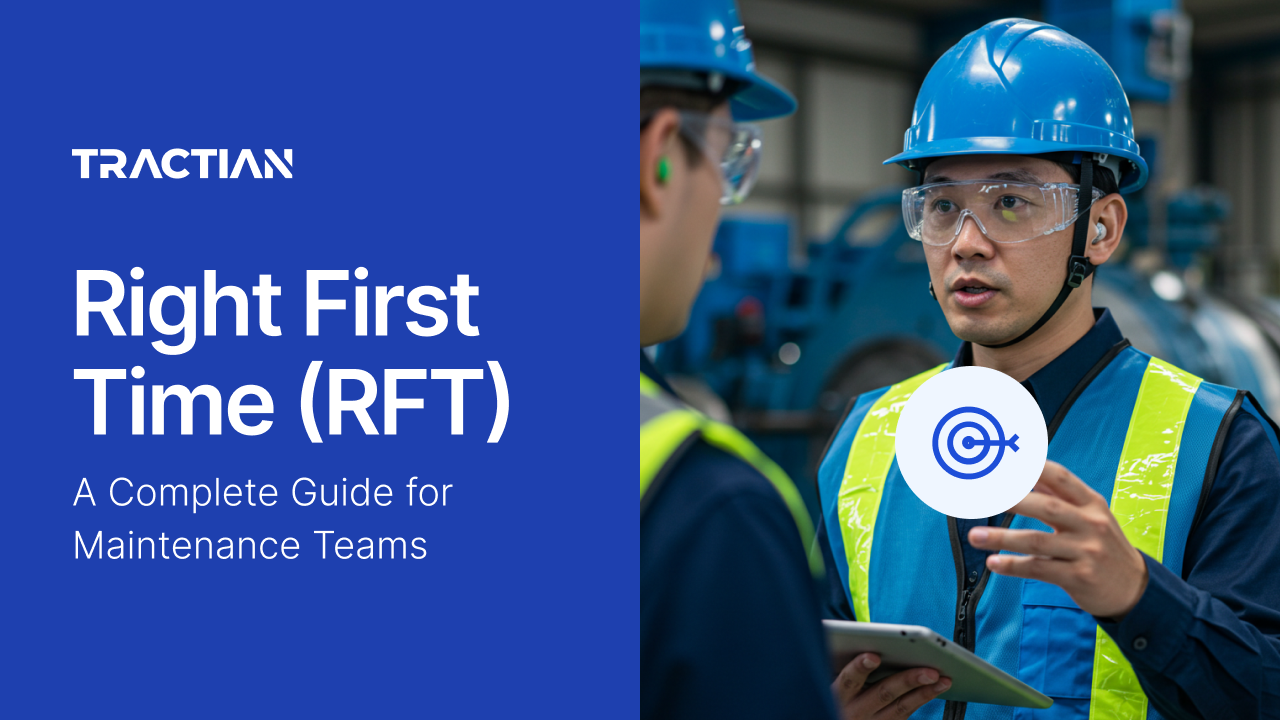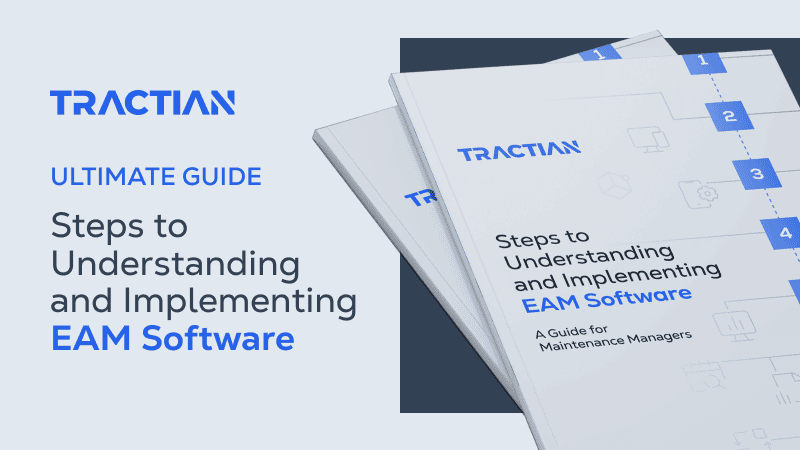Every maintenance team knows the frustration of fixing the same problem twice. A bearing replacement that doesn't last as long as expected. A pump seal that starts leaking before the next shift. A calibration that drifts out of spec before the month is over.
Yes, these recurring issues waste time and money. However, they also erode confidence in your maintenance program. So, what do you do? The solution to this isn't working harder or faster. What’s needed is a systematic approach called Right First Time (RTF).
RTF, once implemented, eliminates rework by methodically helping maintenance teams get tasks done correctly on the initial attempt. This comprehensive guide will show you how to measure, implement, and sustain RFT practices that will transform maintenance quality from a reactive and chaotic firefighting mentality into a proactive and reliability-building system.
What Is Right First Time Metric In Maintenance?
Right First Time (RFT) is a quality management principle where maintenance tasks are completed correctly on the initial attempt, eliminating the need for rework, additional inspections, or repeat visits. In maintenance operations, this means getting the repair, replacement, or preventive task done properly the first time a technician touches the equipment.
Though RFT originated in manufacturing quality systems, it has become essential for maintenance teams dealing with increasingly complex assets and tighter operational windows. Unlike reactive maintenance approaches that accept rework as normal, RFT philosophy treats every maintenance intervention as an opportunity to achieve lasting results.
The difference between traditional maintenance and RFT is less about doing good work and more about systematic preparation, standardized execution, and verification that eliminates guesswork. When a bearing replacement is done right the first time, that asset stays in service longer, costs less to maintain, and doesn't surprise you with an unexpected failure two weeks later.
First time quality matters for asset reliability because every maintenance action either extends or shortens equipment life. Poor initial work creates cascading problems that compound over time, while RFT execution builds reliability into every intervention.
Why Do It Right The First Time Matters To Asset Reliability
When maintenance work fails to achieve lasting results, the consequences ripple through your entire operation in ways that go far beyond the immediate repair cost. Asset reliability depends on each maintenance intervention building upon previous work rather than undoing it.
Getting it right the first time directly reduces unplanned downtime by preventing the recurring issues that plague reactive maintenance programs. A properly torqued connection doesn't loosen prematurely. A correctly aligned coupling doesn't create vibration that damages bearings. A thoroughly cleaned heat exchanger doesn't foul again within weeks.
The relationship between first pass quality and equipment lifespan is straightforward but often overlooked. Every time maintenance work has to be redone, the asset experiences additional stress from the failure, the repair process, and the restart cycle. Components that should last years begin failing in months when subjected to repeated interventions.
Cost savings from RFT implementation show up in multiple areas that maintenance teams can track and measure. Here's where you'll see the biggest impact:
- Reduced Downtime: Fewer repeat failures mean more productive hours and less emergency response
- Extended Asset Life: Proper maintenance execution preserves original equipment specifications and performance
- Lower Maintenance Costs: Eliminating rework cuts labor hours, parts consumption, and overtime expenses
- Improved Safety: Consistent, quality work reduces the risk of equipment-related incidents
- Enhanced Production Quality: Reliable equipment produces more consistent output with fewer defects
Consider what happens when a pump seal replacement is done incorrectly. The initial failure has a cost on production in both time and parts. The rework doubles labor hours and may require expedited parts. The repeated failures damage the pump shaft and turn a routine seal job into a major overhaul.
Definition Of RFT And FTR Calculation Methods
Right First Time (RFT) and First Time Right (FTR) are often used interchangeably in maintenance contexts, though some organizations distinguish between them based on specific quality frameworks. Both terms measure the percentage of maintenance tasks completed successfully without requiring additional work or corrections.
Understanding what FTR means in practical terms helps maintenance teams establish clear performance targets. The mathematical foundation of RFT measurement provides maintenance teams with a clear, trackable metric that connects daily work quality to long-term reliability outcomes.

Step 1: Calculate Defect-Free Tasks
Identifying defect-free maintenance tasks requires clear criteria for what constitutes successful completion versus work requiring correction. A defect-free task meets all specified requirements, passes quality checks, and doesn't generate follow-up work orders within a defined period.
Examples of defect-free tasks include a bearing replacement that runs smoothly for its expected service life, a preventive maintenance inspection that accurately identifies all issues, or a calibration that maintains accuracy throughout the next service interval.
The "first attempt" in maintenance contexts means the work was completed during the originally scheduled maintenance window without requiring additional visits, parts, or labor beyond what was planned.
Step 2: Determine Total Tasks
Accurately tracking total maintenance tasks requires consistent definitions and documentation practices across all maintenance activities. This includes preventive maintenance, corrective repairs, emergency responses, and improvement projects that affect asset performance.
The measurement period should align with your maintenance planning cycles (typically monthly or quarterly) to provide meaningful data for decision-making. Task definition consistency ensures that similar work is counted the same way regardless of which technician performs it or when it occurs.
Step 3: Evaluate RFT Percentage
Here's where the numbers tell the story. The RFT calculation formula is:
RFT% = (Number of defect-free tasks ÷ Total number of tasks) × 100
For instance, the RFT percentage can be calculated by dividing the number of maintenance tasks completed without the need for rework or follow-up by the total number of tasks performed in a given period, and then multiplying by 100.
Different percentage ranges indicate varying levels of maintenance performance maturity. Low RFT rates may indicate underlying challenges with procedures, training, or resource availability. RFT rates in this range typically suggest that a maintenance program is progressing but still has opportunities to further improve its processes and outcomes. High RFT rates are often associated with mature maintenance operations that have established strong quality systems.
First Time Right Steps For Maintenance Workflows
Building RFT capability into maintenance workflows requires systematic changes that address the root causes of rework rather than just measuring its occurrence. These changes must be practical enough for daily implementation while comprehensive enough to drive lasting improvement.
Standardize Maintenance Checklists
Standardized procedures eliminate the variation that leads to inconsistent results and rework. Effective maintenance checklists go beyond simple task lists to include verification steps, quality checks, and troubleshooting guidance that helps technicians handle unexpected conditions.
Creating effective maintenance checklists starts with documenting the best practices of your most experienced technicians. These procedures should include specific torque values, alignment tolerances, cleanliness standards, and safety requirements that ensure consistent results regardless of who performs the work.
Digital checklists provide additional benefits by ensuring steps can't be skipped, capturing completion data automatically, and linking to asset histories that inform current work. They also enable real-time updates when procedures change or improvements are identified.
Train Teams On First Pass Meaning
Proper training ensures technicians understand both the technical requirements and quality expectations for each maintenance task. This should include items beyond basic skill development, such as the reasoning behind procedures and the consequences of shortcuts or incomplete work.
Understanding first pass meaning helps technicians recognize that quality isn't just about following steps. It's about understanding why each step matters for long-term reliability. Technical skill development approaches should combine hands-on practice with theoretical understanding.
Knowledge transfer methods from experienced to newer technicians preserve institutional knowledge and prevent the loss of hard-won expertise. Regular review of RFT metrics, failure analysis results, and technician feedback creates a culture of continuous improvement.
Castertech was able to Reduce Maintenance Hours quickly by adopting Tractian CMMS. "Digital work orders replaced endless paperwork, helping our teams focus on doing it right the 1st time. We saw fewer interruptions, more consistent task scheduling, and a direct drop in rework." - Maintenance Coordinator, Castertech.
How To Reduce Defects With Right-First-Time Quality Assurance
Quality assurance in maintenance operations focuses on preventing defects rather than detecting them after work is complete. This proactive approach requires systematic identification of failure modes and implementation of controls that eliminate their root causes.
Target Root Causes
Effective root cause analysis in maintenance not only identifies what failed, but also seeks to understand why it failed and how to prevent recurrence. The most common root cause analysis techniques (5 Whys, Fishbone diagrams, and failure mode analysis) provide structured approaches to this investigation.
Technician feedback plays a crucial role in identifying process weaknesses that may not be apparent from failure data alone. Experienced technicians often recognize early warning signs, procedural gaps, or resource constraints that contribute to quality problems.
Use A Percentage Of Defective Units As A Common Performance Measure
Tracking defect percentages provides visibility into improvement opportunities and helps prioritize quality initiatives. This metric should be tracked at multiple levels (individual technician, work type, asset class, and overall maintenance program) to identify specific areas needing attention.
Setting up measurement systems for defect tracking requires clear definitions of what constitutes a defect, consistent data collection methods, and regular review cycles. The measurement system should be simple enough for daily use but comprehensive enough to capture meaningful trends.
Connecting defect rates to specific maintenance processes or teams enables targeted improvement efforts. Rather than implementing broad changes across all maintenance activities, teams can focus resources on the areas with the greatest impact potential.
Connecting RFT Metric To Cost And Downtime Reduction
The financial impact of improving RFT rates extends far beyond the immediate cost of rework. Maintenance teams that can translate RFT improvements into business value create compelling cases for continued investment in quality initiatives and process improvement.
The relationship between RFT and mean time between failures (MTBF) is direct and measurable. Higher RFT rates lead to longer intervals between failures, which reduces both planned and unplanned maintenance costs while increasing productive capacity.
Calculating the cost of rework requires tracking multiple cost categories that are often hidden in maintenance budgets. Labor costs include not just the time spent redoing work, but also the opportunity cost of not performing other maintenance tasks.
Cost categories affected by poor RFT performance include several key areas:
- Direct labor costs: Additional technician hours required for rework and repeat visits
- Replacement parts: Extra components needed due to damage from improper installation or premature failure
- Production losses: Revenue lost during extended downtime caused by maintenance rework
- Quality issues: Product defects or customer complaints resulting from unreliable equipment
- Overtime expenses: Premium labor costs for emergency repairs that could have been prevented
Define FTR To Improve First Time Fix Rate
First Time Right (FTR) in the context of fix rates focuses specifically on repair effectiveness rather than general maintenance quality. This metric measures how often repair work actually solves the problem without requiring additional interventions.
FTR differs from general RFT by emphasizing the diagnostic accuracy and repair completeness that prevent recurring failures. A high first time fix rate indicates that maintenance teams correctly identify root causes and implement lasting solutions rather than temporary fixes.
Identify Repeated Failures
Tracking and analyzing recurring issues requires systematic failure coding that captures both the failure mode and the underlying cause. This coding system should be detailed enough to identify patterns but simple enough for consistent use by all technicians.
Tracking mean time between repairs (MTBR) on the same asset helps identify chronic problems that require different approaches than routine maintenance. Assets with short intervals between repairs may need design modifications, operating procedure changes, or replacement rather than continued repair.
Track Time Approach Metrics
Measuring and improving the efficiency of maintenance response involves tracking multiple time-related metrics that affect both cost and reliability. These metrics help identify bottlenecks and improvement opportunities in maintenance workflows.
Methods for tracking time-to-completion include automated data collection from work order systems, manual logging by technicians, and analysis of production records. The key is consistent measurement that captures both planned and unplanned maintenance activities.
Analyzing variations in completion times across similar tasks reveals opportunities for standardization and improvement. Large variations often indicate procedural inconsistencies, resource constraints, or skill gaps that can be addressed through training or process changes.
Ensuring First Time Quality In Every Process
Creating a culture of quality and continuous improvement requires the systematic implementation of RFT principles across all maintenance processes. This cultural transformation encompasses planning, resource allocation, and performance measurement.
Developing RFT mindsets in maintenance teams starts with clear communication of quality expectations and the business reasons behind them. Technicians need to understand how their work quality affects overall plant performance and their own job security.
Leadership support for RFT initiatives must be visible and consistent. This includes providing necessary resources, recognizing quality achievements, and addressing systemic barriers that prevent teams from doing quality work.
The connection between RFT and overall maintenance excellence becomes apparent as teams mature in their quality practices. Organizations with high RFT rates typically also excel in safety, cost control, and reliability metrics because the same systematic approach drives improvement in all areas.
Elevate your right-first-time approach with a platform designed to manage tasks and track asset history in real time. Try Tractian CMMS and see immediate improvements in your RFT metrics.
How Tractian CMMS Elevates Right First Time Performance
Achieving consistent RFT results requires more than good intentions and skilled technicians. You need systematic support for quality execution at every step of the maintenance process, from initial planning through final verification.
Here's the challenge most maintenance teams face with this: even with the best training and procedures in place, the presence of information gaps, communication breakdowns, and resource constraints prevents technicians from doing quality work. What looks good on paper will fall apart in practice when technicians don't have the right information at the right time.
Tractian CMMS was built to solve exactly these problems. Digital work orders ensure technicians have complete, accurate information before starting any task. Asset histories provide context that helps teams understand failure patterns and select appropriate repair strategies. The platform's mobile-first design means quality checks and verification steps happen in real time, not as afterthoughts.
Tractian CMMS also tracks the metrics that matter for RFT improvement. Completion rates, rework frequency, and time-to-repair data flow automatically into dashboards that help maintenance leaders identify improvement opportunities and measure progress over time.
Ready to transform your maintenance quality?


